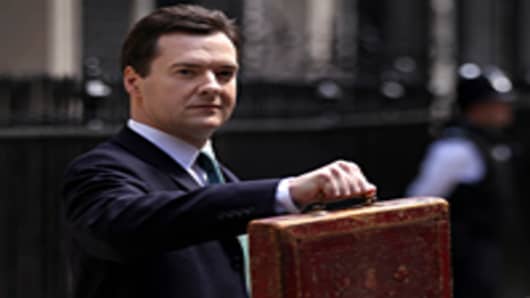Ministers are set to be told this autumn that a £12 billion ($18.8 billion) black hole has opened in the public finances, in a forecast that threatens to derail the coalition’s deficit reduction strategy and prolong austerity well into the next parliament.
The Financial Times has replicated the model of government borrowing used by the independent Office for Budget Responsibility, which suggests the structural deficit in 2011-12 is now £12 billion higher than thought, a rise of 25 per cent.
By repeating and extending the fundamental elements of the OBR methodology, it is clear that even if there is no slippage in borrowing from previous forecasts, the level of spare capacity in the economy is lower than expected, so the OBR will not be able to forecast as much catch-up growth as it did in March.
More of the deficit appears permanent and will not be eliminated by a bounce back in the economy.
With only two months to go before the chancellor’s autumn statement on November 29, the coalition is on course to face the choice of prolonging austerity measures well into the next parliament or to introduce more spending cuts or tax increases to balance the government’s books on the current schedule.
One minister told the FT there had been “agonised discussions” in recent months about whether the Treasury should try to further tighten the fiscal screw if the structural deficit turned out to be bigger than expected.
Putting the public finances back on track at the next Budget would require the equivalent of raising value-added tax from 20 percent to 22.5 percent. No decisions have been taken, although some in the Treasury argue that further fiscal measures would be needed in such circumstances.
However, senior Liberal Democrats attending the party’s annual conference in Birmingham insisted there should be no deviation from existing fiscal plans. “In those circumstances – and with global growth slowing – would the markets really expect us to go even further?” said one.
The prospect of further or longer austerity will come as a nasty jolt to coalition ministers who have spent the past two weeks debating whether to drop the 50p tax rate or to cut other taxes.
Some senior ministers in government are aware of the looming problem because a similar exercise has been undertaken in Whitehall and insist they would prefer to prolong the pain of deficit reduction rather than slap taxes on consumers now.
But such action may lead to the government breaching its fiscal mandate little over a year after putting it in place.
The FT research, conducted over the summer, shows much less spare capacity in the economy than the OBR had expected, a finding that will force it to predict slower economic growth in the years ahead and further slippage in deficit reduction.
Economists use spare capacity estimates to determine the amount of government borrowing that will fall away as the economy recovers, and the amount that requires tax rises or spending cuts to eliminate it.
In March, the OBR estimated that the current budget deficit would be £99 billion in 2011-12, of which £49 billion was persistent and needed action over this parliament.
Robert Chote, OBR chairman, justified these figures at the time on the basis that the estimate of spare capacity in 2011-12 would be 3.9 percent of national income.
But as the Bank of England and the International Monetary Fund have said recently, evidence has been mounting that the degree of spare capacity in the economy is much smaller than previously thought, so the recovery will be weaker.
Using OBR methodology, which was published in April, the FT has calculated that the best current estimate of the output gap in the second quarter of 2011 is 2.6 percent of national income.
This change alone raises the structural deficit in 2011-12 from £49 billion to £61 billion, an increase of almost a quarter. It also puts the coalition’s deficit reduction plan in jeopardy because George Osborne’s Budget ambition of eliminating the current structural deficit one year early in 2014-15 would appear beyond reach and his likelihood of meeting the target by 2015-16 falls dramatically.
The OBR has seen the FT’s calculations of spare capacity and said they were consistent with its methodology. Mr Chote added: “Bear in mind that the methodology could change in future forecasts if we identify potential improvements”.


